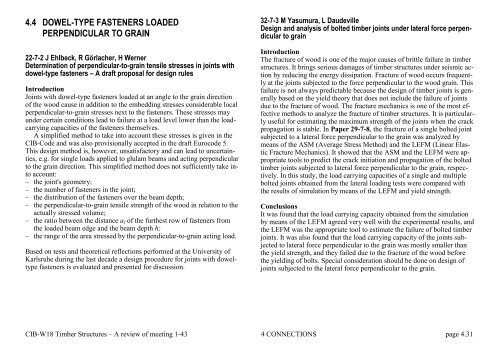Download pdf - CIB-W18
Download pdf - CIB-W18
Download pdf - CIB-W18
- TAGS
- download
- cib-w18.com
You also want an ePaper? Increase the reach of your titles
YUMPU automatically turns print PDFs into web optimized ePapers that Google loves.
4.4 DOWEL-TYPE FASTENERS LOADED<br />
PERPENDICULAR TO GRAIN<br />
22-7-2 J Ehlbeck, R Görlacher, H Werner<br />
Determination of perpendicular-to-grain tensile stresses in joints with<br />
dowel-type fasteners – A draft proposal for design rules<br />
Introduction<br />
Joints with dowel-type fasteners loaded at an angle to the grain direction<br />
of the wood cause in addition to the embedding stresses considerable local<br />
perpendicular-to-grain stresses next to the fasteners. These stresses may<br />
under certain conditions lead to failure at a load level lower than the loadcarrying<br />
capacities of the fasteners themselves.<br />
A simplified method to take into account these stresses is given in the<br />
<strong>CIB</strong>-Code and was also provisionally accepted in the draft Eurocode 5.<br />
This design method is, however, unsatisfactory and can lead to uncertainties,<br />
e.g. for single loads applied to glulam beams and acting perpendicular<br />
to the grain direction. This simplified method does not sufficiently take into<br />
account:<br />
– the joint's geometry;<br />
– the number of fasteners in the joint;<br />
– the distribution of the fasteners over the beam depth;<br />
– the perpendicular-to-grain tensile strength of the wood in relation to the<br />
actually stressed volume;<br />
– the ratio between the distance ar of the furthest row of fasteners from<br />
the loaded beam edge and the beam depth h;<br />
– the range of the area stressed by the perpendicular-to-grain acting load.<br />
Based on tests and theoretical reflections performed at the University of<br />
Karlsruhe during the last decade a design procedure for joints with doweltype<br />
fasteners is evaluated and presented for discussion.<br />
32-7-3 M Yasumura, L Daudeville<br />
Design and analysis of bolted timber joints under lateral force perpendicular<br />
to grain<br />
Introduction<br />
The fracture of wood is one of the major causes of brittle failure in timber<br />
structures. It brings serious damages of timber structures under seismic action<br />
by reducing the energy dissipation. Fracture of wood occurs frequently<br />
at the joints subjected to the force perpendicular to the wood grain. This<br />
failure is not always predictable because the design of timber joints is generally<br />
based on the yield theory that does not include the failure of joints<br />
due to the fracture of wood. The fracture mechanics is one of the most effective<br />
methods to analyze the fracture of timber structures. It is particularly<br />
useful for estimating the maximum strength of the joints when the crack<br />
propagation is stable. In Paper 29-7-8, the fracture of a single bolted joint<br />
subjected to a lateral force perpendicular to the grain was analyzed by<br />
means of the ASM (Average Stress Method) and the LEFM (Linear Elastic<br />
Fracture Mechanics). It showed that the ASM and the LEFM were appropriate<br />
tools to predict the crack initiation and propagation of the bolted<br />
timber joints subjected to lateral force perpendicular to the grain, respectively.<br />
In this study, the load carrying capacities of a single and multiple<br />
bolted joints obtained from the lateral loading tests were compared with<br />
the results of simulation by means of the LEFM and yield strength.<br />
Conclusions<br />
It was found that the load carrying capacity obtained from the simulation<br />
by means of the LEFM agreed very well with the experimental results, and<br />
the LEFM was the appropriate tool to estimate the failure of bolted timber<br />
joints. It was also found that the load carrying capacity of the joints subjected<br />
to lateral force perpendicular to the grain was mostly smaller than<br />
the yield strength, and they failed due to the fracture of the wood before<br />
the yielding of bolts. Special consideration should be done on design of<br />
joints subjected to the lateral force perpendicular to the grain.<br />
<strong>CIB</strong>-<strong>W18</strong> Timber Structures – A review of meeting 1-43 4 CONNECTIONS page 4.31














